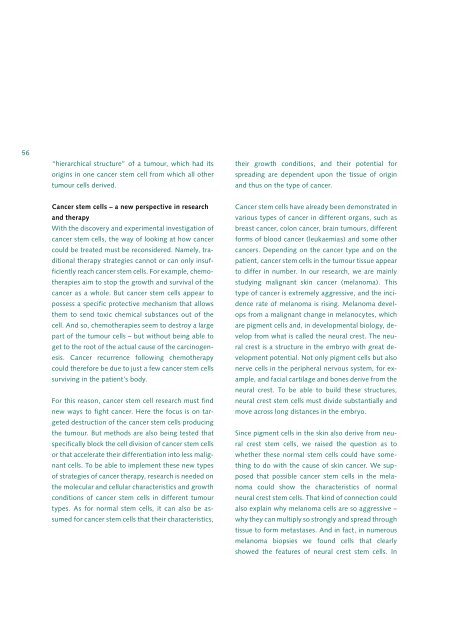Cancer Research in Switzerland - Krebsliga Schweiz
Cancer Research in Switzerland - Krebsliga Schweiz
Cancer Research in Switzerland - Krebsliga Schweiz
Create successful ePaper yourself
Turn your PDF publications into a flip-book with our unique Google optimized e-Paper software.
56<br />
“hierarchical structure” of a tumour, which had its<br />
orig<strong>in</strong>s <strong>in</strong> one cancer stem cell from which all other<br />
tumour cells derived.<br />
<strong>Cancer</strong> stem cells – a new perspective <strong>in</strong> research<br />
and therapy<br />
With the discovery and experimental <strong>in</strong>vestigation of<br />
cancer stem cells, the way of look<strong>in</strong>g at how cancer<br />
could be treated must be reconsidered. Namely, traditional<br />
therapy strategies cannot or can only <strong>in</strong>sufficiently<br />
reach cancer stem cells. For example, chemotherapies<br />
aim to stop the growth and survival of the<br />
cancer as a whole. But cancer stem cells appear to<br />
possess a specific protective mechanism that allows<br />
them to send toxic chemical substances out of the<br />
cell. And so, chemotherapies seem to destroy a large<br />
part of the tumour cells – but without be<strong>in</strong>g able to<br />
get to the root of the actual cause of the carc<strong>in</strong>ogenesis.<br />
<strong>Cancer</strong> recurrence follow<strong>in</strong>g chemotherapy<br />
could therefore be due to just a few cancer stem cells<br />
surviv<strong>in</strong>g <strong>in</strong> the patient’s body.<br />
For this reason, cancer stem cell research must f<strong>in</strong>d<br />
new ways to fight cancer. Here the focus is on targeted<br />
destruction of the cancer stem cells produc<strong>in</strong>g<br />
the tumour. But methods are also be<strong>in</strong>g tested that<br />
specifically block the cell division of cancer stem cells<br />
or that accelerate their differentiation <strong>in</strong>to less malignant<br />
cells. To be able to implement these new types<br />
of strategies of cancer therapy, research is needed on<br />
the molecular and cellular characteristics and growth<br />
conditions of cancer stem cells <strong>in</strong> different tumour<br />
types. As for normal stem cells, it can also be assumed<br />
for cancer stem cells that their characteristics,<br />
their growth conditions, and their potential for<br />
spread<strong>in</strong>g are dependent upon the tissue of orig<strong>in</strong><br />
and thus on the type of cancer.<br />
<strong>Cancer</strong> stem cells have already been demonstrated <strong>in</strong><br />
various types of cancer <strong>in</strong> different organs, such as<br />
breast cancer, colon cancer, bra<strong>in</strong> tumours, different<br />
forms of blood cancer (leukaemias) and some other<br />
cancers. Depend<strong>in</strong>g on the cancer type and on the<br />
patient, cancer stem cells <strong>in</strong> the tumour tissue appear<br />
to differ <strong>in</strong> number. In our research, we are ma<strong>in</strong>ly<br />
study<strong>in</strong>g malignant sk<strong>in</strong> cancer (melanoma). This<br />
type of cancer is extremely aggressive, and the <strong>in</strong>cidence<br />
rate of melanoma is ris<strong>in</strong>g. Melanoma develops<br />
from a malignant change <strong>in</strong> melanocytes, which<br />
are pigment cells and, <strong>in</strong> developmental biology, develop<br />
from what is called the neural crest. The neural<br />
crest is a structure <strong>in</strong> the embryo with great development<br />
potential. Not only pigment cells but also<br />
nerve cells <strong>in</strong> the peripheral nervous system, for example,<br />
and facial cartilage and bones derive from the<br />
neural crest. To be able to build these structures,<br />
neural crest stem cells must divide substantially and<br />
move across long distances <strong>in</strong> the embryo.<br />
S<strong>in</strong>ce pigment cells <strong>in</strong> the sk<strong>in</strong> also derive from neu<br />
ral crest stem cells, we raised the question as to<br />
whether these normal stem cells could have someth<strong>in</strong>g<br />
to do with the cause of sk<strong>in</strong> cancer. We supposed<br />
that possible cancer stem cells <strong>in</strong> the melanoma<br />
could show the characteristics of normal<br />
neural crest stem cells. That k<strong>in</strong>d of connection could<br />
also expla<strong>in</strong> why melanoma cells are so aggressive –<br />
why they can multiply so strongly and spread through<br />
tissue to form metastases. And <strong>in</strong> fact, <strong>in</strong> numerous<br />
melanoma biopsies we found cells that clearly<br />
showed the features of neural crest stem cells. In

















